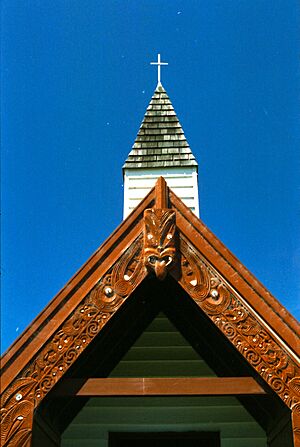Māori religion facts for kids
Māori religion includes the different spiritual beliefs and practices of the Māori people, who are the native people of New Zealand.
Contents
Traditional Māori Beliefs
Before Europeans arrived, Māori had a traditional belief system. This system was very similar to the beliefs of their ancestors from Polynesia. They believed that everything, including nature and all living things, was connected. This connection was like a family tree, called whakapapa or genealogy.
Because of this connection, Māori believed that everything had a special life force. This life force was called mauri. For example, the ocean had a spirit, and so did the forests and plants.
Here are some important spirits from traditional Māori beliefs:
- Tangaroa was the spirit of the ocean. He was seen as the ancestor of all fish.
- Tāne was the spirit of the forest. He was the ancestor of all birds.
- Rongo was the spirit of peace and farming. He was the ancestor of all plants grown for food.
Some people also believed in a supreme being named Io. However, this idea is debated by some.
Tapu and Mana: Special Powers and Rules
Traditional Māori beliefs include important ideas like tapu and mana.
Mana is a spiritual power or special essence. It can be found in certain people and objects. In the past, people of high rank in a tribe had a lot of mana. They would not touch things belonging to people of lower rank. This was because it was thought to "pollute" the mana. Also, people of lower rank could not touch things belonging to high-ranking people without risking serious consequences.
Tapu means "sacred" or "forbidden." It involves rules and things you are not allowed to do. There are two types of tapu:
- Private tapu affects individuals.
- Public tapu affects whole communities.
If a person, object, or place is tapu, it might not be touched. Sometimes, you couldn't even go near it. Something could be made tapu for a certain time to make it sacred.
In the past, tapu was a very strong force in Māori life. Breaking a tapu rule could have serious results. For example, food cooked for a high-ranking person was tapu. It could not be eaten by someone of lower rank. A chief's house was also tapu, and the chief could not eat inside it. Not only houses, but also clothes and other belongings of important people were tapu. Burial grounds and places where people died were always tapu. These areas were often fenced off.
Today, tapu is still important, especially for sickness, death, and burials:
- Tangihanga are funeral ceremonies. They usually last two or three days. The person who has passed away lies in an open coffin. Family members, usually women, sit beside them. They wear black and sometimes have kawakawa leaves on their heads. Visitors come to speak to the deceased, sharing memories and feelings. It's okay to show sadness openly. Traditional beliefs are often shared, and the deceased is told to return to the ancestral homeland, Hawaiki. Close family members, called kiri mate, do not speak during this time. On the last night, called pō whakamutunga, mourners stay awake. At sunrise, the coffin is closed. Then, there is usually a church or marae (meeting ground) funeral service and burial. After the burial, it's traditional for mourners to wash their hands and sprinkle water on their heads. A meal is often served afterward. Mourners are expected to give koha (gifts) to help with the meal. The home of the person who died and the place where they passed away are ritually cleaned. This is done with karakia (prayers) and a ceremony called takahi whare, which means "trampling the house." That night, the pō whakangahau (night of entertainment) is a time for relaxation. The husband or wife of the deceased is not left alone for several nights.
- During the year after a prominent person's death, their family might visit other marae. They "bring the death" (kawe mate) by carrying pictures of the person.
- Hura kōwhatu are ceremonies to unveil headstones. These are usually held about a year after a death. They often happen on a public holiday so more visitors can attend. People remember the deceased and express their grief again.
Christianity in Māori Culture
In the early 1800s, many Māori people started to accept Christianity. A lot of Māori joined the Church of England and the Roman Catholic Church. Both of these churches are still very important in Māori society today.
The Church of England in New Zealand has long recognized Māori leadership. They have Māori priests who become Bishop of Aotearoa. One well-known bishop was Rev. Whakahuihui Vercoe. He gave a very direct speech to Queen Elizabeth II during a Waitangi Day ceremony. The Roman Catholic Church also has Māori in high positions. Other churches, like the Presbyterian Church, were also successful in the 1800s. The Church of Jesus Christ of Latter-day Saints also gained many Māori followers from the 1880s onwards. By 1901, nearly 4,000 Māori were members in 79 different church groups.
Today, Christian prayer (called karakia) is a common way to start and end many Māori public gatherings. Prayers are also said at the beginning of new projects, journeys, and other important activities.
Images for kids
See also
 In Spanish: Religión maorí para niños
In Spanish: Religión maorí para niños



